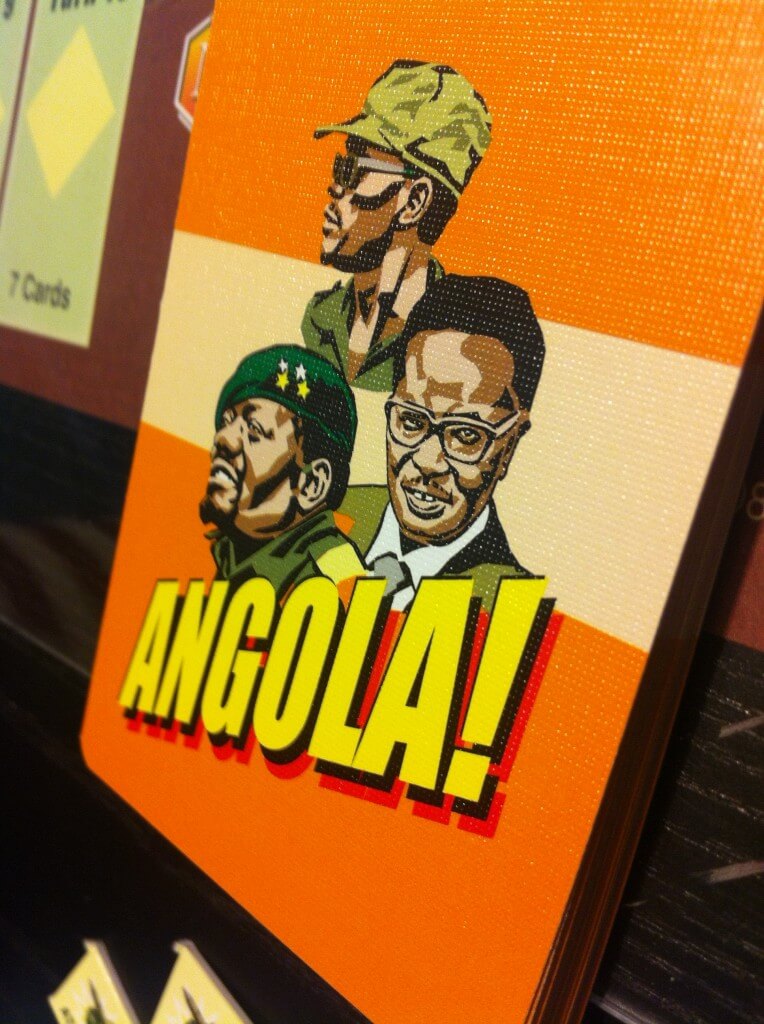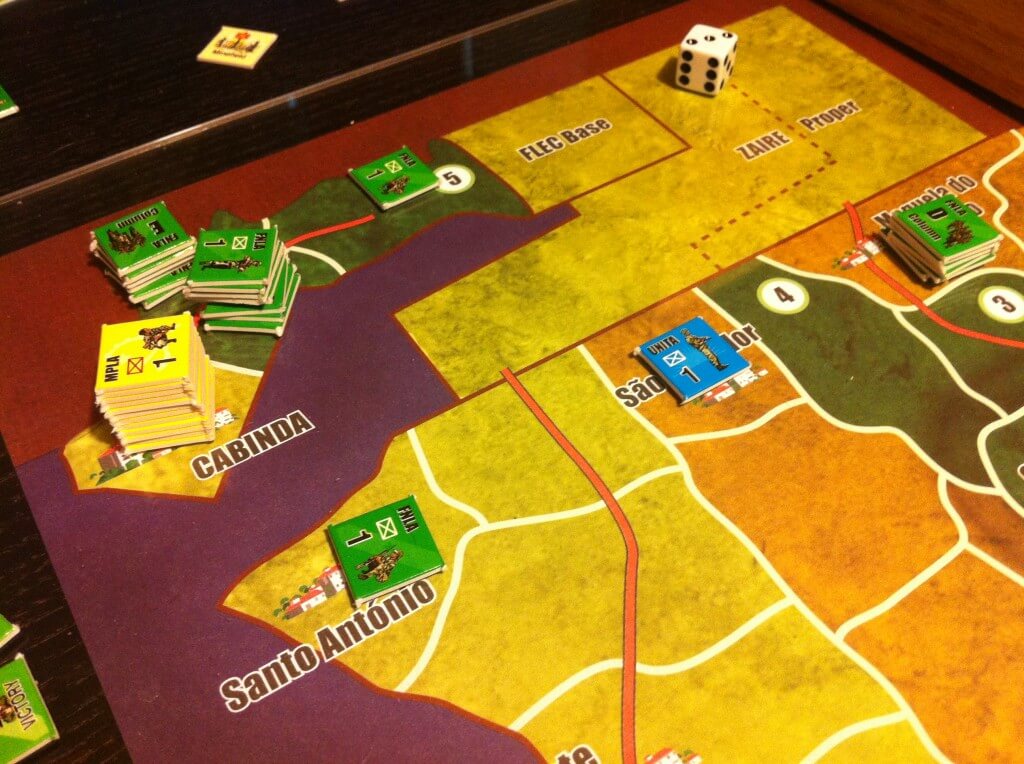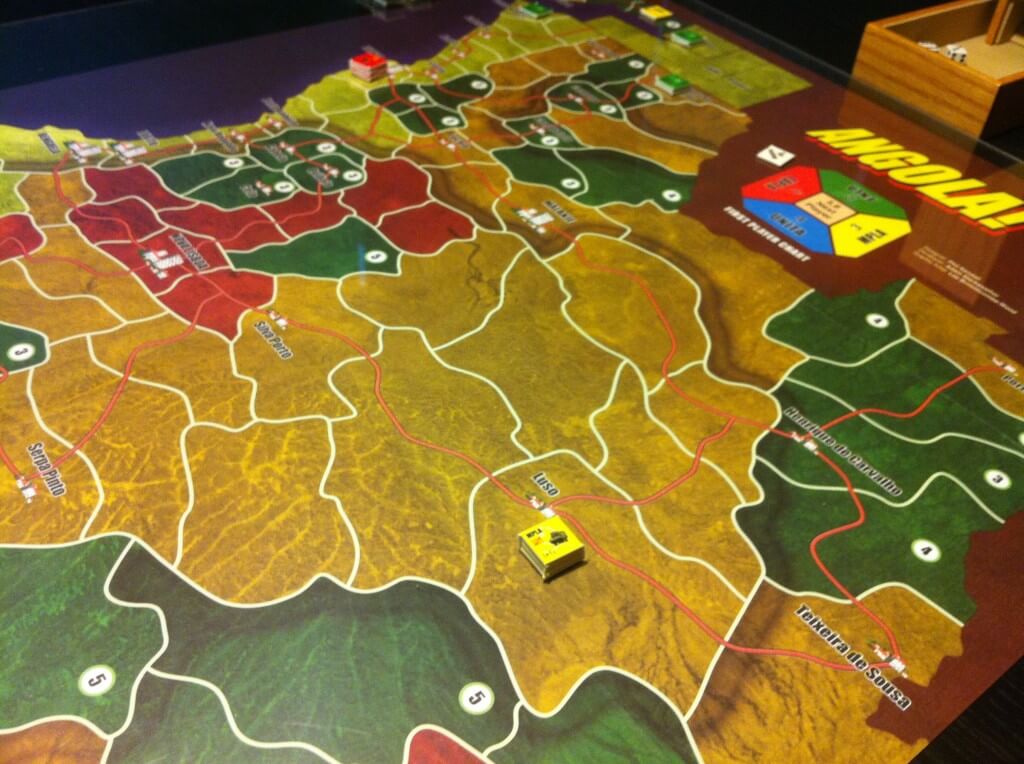Angola is a an attempt at a simulation of a vicious war between various factions in the decade long Civil war of Angola.

Why the hell play a war game about a civil war in Angola? Who cares…..? You do. This was also a nice little proxy fight between the two cold war Super Powers. Not enough for ya?
The 27-year war can be divided roughly into three periods of major fighting – between 1975 and 1991, 1992 and 1994, and 1998 and 2002 – broken up by fragile periods of peace. By the time the MPLA finally achieved victory in 2002, an estimated 500,000 people had been killed and over one million internally displaced. The war devastated Angola’s infrastructure, and dealt severe damage to the nation’s public administration, economic enterprises, and religious institutions.
The Angolan Civil War reached such dimensions due to the combination of Angola’s violent internal dynamics and massive foreign intervention. Both the Soviet Union
and the United States
considered the conflict critical to the global balance of power and to the outcome of the Cold War, and they and their allies put significant effort into making it a proxy war between their two power blocs. The Angolan Civil War ultimately became one of the bloodiest, longest, and most prominent armed conflicts of the Cold War.
Overview from our co player Cisco:
“Next review – ANGOLA!
Now, this is a fun game. There re 4 factions, and two alliances with 2 factions each. The allied players are trying to win together, but you can’t cooperate with each other too much, except perhaps with sharing of airpower (we need to verify that), and you defend together if you’re in the same region with your ally.

You have troops that are running around, trying to take over towns and cities, with a few really important cities, that you have to defend with your life. The terrain is very inhospitable, so most movement is done along roads.
And the roads come into some critical chokepoints in parts of the map, which tends to attract major battles.
Each player gets trickles of reinforcements and replacements, and they also get help from outside benefactors, which supply the “heavy” stuff, such as tanks and artillery and airpower and mercenaries. Anti-air missiles and anti-tank missiles and mines are also in the mix, so battles are often very “colorful” affairs.
The combat system itself is quite unique, and its designed to highlight each kind of weapon system, sort of like a band playing, that lets each member do a solo performance, so you can see what they can do. Its a multi-step combat system that can cause units to die outright, or be suppressed, before you calculate odds, and sometimes battles can go on for a second round (and I suppose a 3rd and 4th, although that didn’t happen in our game).

The “good stuff”, such as tanks, mercs, artillery, gives you bonus dies to roll in your combat, so if you’re loaded with lots of goodies, you’re gonna have lots of dies to roll. And you get bonus dies for each region around the combat area that you control, so this is sort of a “home turf” advantage.
So in the end (after all the different weapon systems did what they could do) you roll your die(s), and the enemy rolls his die(s), and you take the die with the highest rolled number, and subtract the enemy’s highest rolled number, and then that leads to the final results (based on where the initial odds were set at). If the attacker rolls 6 dice, and the defender only gets one – he can still win the roll. But, most often not.

Although we did have some combats where a lonely defender with a couple dice rolled a “6”, beating the best the attacker made with 4 or 5 dies. Although in some cases, the initial odds are so lopsided that even great die rolling won’t help much. But, where the odds are like 1-2 or 1-1 or 2-1, that die roll shift is very important, and can often snatch defeat out of the jaws of victory, or vice-versa.
One great mechanic in the game is the part when each player secretly “pleads” for help from their benefactors, and each player takes 1 die, and secretly selects a number from 1-6. This represents how many “covert help” cards you get. So if you select “2”, you get 2 cards. The cards have different amounts and types of goodies you can get, from a “mine” or a couple “anti-tank” missiles, to some good stuff like airpower or artillery. But – whoever picks the highest number, is viewed as a pawn of a superpower, and they lose public support. So its a game of chicken – “how high can I set my die, without becoming the player with the highest number?”. At one point, I purposely chose 6 (much to the chagrin of Brady), cause I wanted to really outfit my new “column” with lots of bling before they headed out into combat. But – thats not something you can do more than once or twice, cause the hit to your alliance’s victory points level is harsh.
Another mechanic is the card deck building – you have to pretty much pre-plan what you are going to do, in each round, by selecting your action cards before the turn, and setting them down in order.

Do you create a new column? (column is like a a HQ – you need them to attack) . Do you move and fight with a column? Do you shuffle some units around? And 3 of the players have different numbers of “blank” cards that they have to put into their deck – basically ‘pass’ cards. The Unita player is the worst handicapped – he has to have two “pass” cards in each deck. Putting the two “pass” cards at the end of my deck, in one of the turns, I found out was not my brightest idea ever. Cause, for the Unita player, if there are 6 cards, and I played all actions for cards 1-4, then … an observant enemy (aka Pete) can deduce my last two cards are blanks.
So there are various mechanics at work in this game, and lots of hard decisions to make. You can’t defend everywhere, and you can’t attack everywhere, and often the enemy’s actions force you to change your strategy. Quite a rollicking wargame – serious battles occur every turn. And I liked the giant bonfire Brady made of the enemy tanks in one combat. Like Brady said, this game needs sounds effects.
Kevin took meticulous notes and pictures, so maybe he’ll be putting together an aar, so me and Brady can relive our glorious victory. 😛 ”
Turn 1 of 10 possible turns.

UNITA advances forces, FNLA moves deeply and heavily into Zaire. FAPLA streams forces into East, dropping some units as a backstop for protecting the western reaches, the forces goal; kill the FNLA in the North and secure our supply routes to the coastal town of Luanda. In round 2 Maranje is attacked by the FAPLA, but they are bloodily replused in fierce urban fighting.
Santo Porto is captured, UNITA take (or) reinforce Benguela. Cambatela falls to FAPLA. The combat and fighting is fast and furious in the North.The FNLA capture the township on the coast of Santo Antonio. In round 3 FNLA is still moving up into Zaire and MPLA forces work the coastal jungles capturing Gabela and Quibala bloodlessly.
FAPLA and MPLA advance quickly from the East to the more central areas to reinforce the coastal regions and acquire towns and villages.
In recruitment, variable recruitment phases many losses are replaced and Brigade size units formed to free up units so they can be brought on elsewhere.
Meanwhile in the Secret aid phase FAPLA goes big with a 5 picking up Tanks, Air(x2) Arty and an Armoured car conversion to tanks. FAPLA/MPLA Alliance won the turn but its neck and neck with just 1 VP separation. Since they won the turn UNITA /FNLA alliance receive support from backers. Real armed forces from the USA and South Africa. Most have big modifiers and large combat strengths of 5-8 versus 1 for local militias. The board is flooded with Green and Blue!
Each turn factions start in a different order based upon a die roll.
Part 2 coming shortly.






Thanks! I had not really known a lot about the war in Angola, so this was a very interesting piece historically as well as from a gaming perspective! Great stuff!
🙂
The toughest thing is managing reinforcements for the FAPLA/ MPLA side. Unlike UNITA/ FNLA who get a steady stream of troops from Zaire and North-West Africa, the Communists have to struggle with slow drip attrition, especially if they lose Luanda and port cities. I LOVE THIS GAME!!!